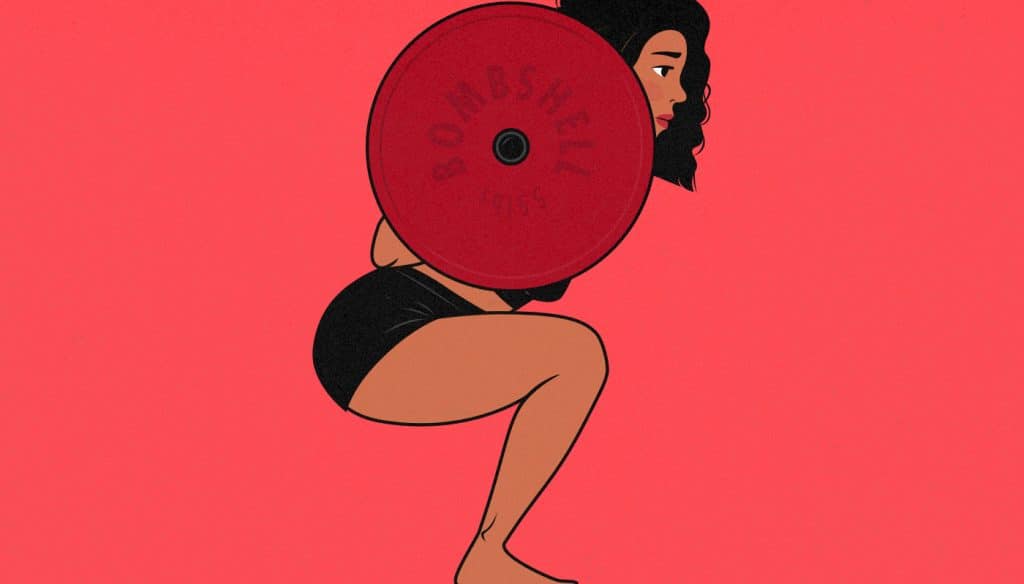
The Women’s Guide to Squatting for Muscle Size
Squats are the bulking lift for women. They’re amazing for bulking up their quads and glutes, and they stimulate more overall muscle mass than any other lift, with the possible exception of the deadlift. But there are many different squat variations, each with its own distinct advantages and disadvantages.
Why Squats Are So Good for Women Who Are Bulking
So, first of all, you may have heard that the squat works over two-hundred muscles. There’s some truth to that. Most of the muscles in our bodies will need to work together to stabilize the weight, whether that’s our spinal erectors keeping our backs straight, our calves keeping us from falling over, or our lats keeping the barbell pulled in nice and tight.
However, just because a muscle is active doesn’t mean that a muscle is being challenged. If we consider our calves, sure, they’ll be putting in work. And as beginners, they might even be putting in enough work during a squat to grow. But as soon as our calves are strong enough to keep us from tipping over, they’ll stop limiting us on the squat, and so they’ll stop getting a growth stimulus.
Squat Muscles Worked
So although squats work most of the muscles in our bodies, the limiting factors are our:
- quads (front of thighs)
- glutes
- adductors (part of the thighs that help stabilize)
- and our spinal erectors
Those are the muscles that will grow most from a squat.
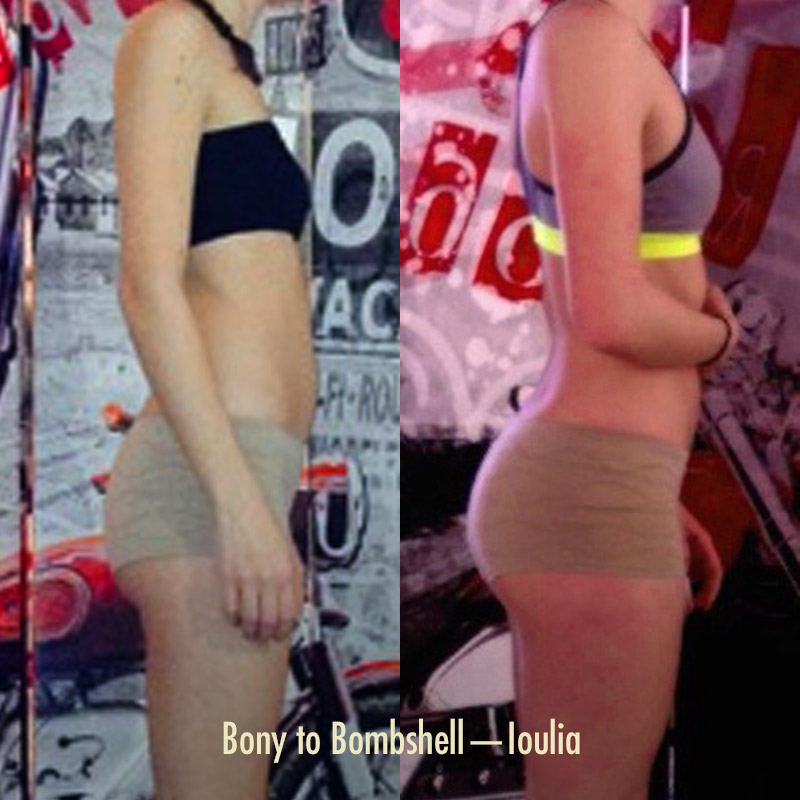
Quads Are The Largest Muscle
Our quads are the largest muscles in our bodies, with our glutes coming in second. And not by a small margin, either. Our quads are four times as big as our shoulders, our glutes are twelve times as big as our biceps (source). These are huge muscles with tremendous potential for growth. That makes them great muscles to target when trying to gain weight as a woman.
(Note that we aren’t mentioning hamstrings. They’re active during squats, but they aren’t a limiting factor, and so they rarely see much growth from squatting. It’s the conventional deadlift or Romanian deadlift that takes care of our hamstrings.)
So it’s not that squats work a large number of muscles, but rather that the squats work our very biggest muscles very hard. We’re only training 3–4 groups of muscles, but the muscles are so incredibly big that we’re working about half of the muscle mass in our bodies.
Squat Benefits For Women
As you can imagine, this makes squats amazing for women bulking up, and the benefits go beyond the obvious:
- Bigger hips, glutes, and thighs: an obvious benefit, yes, but a great one nonetheless.
- Much more overall muscle mass: which comes along with benefits such as higher insulin sensitivity, better blood sugar regulation, and a longer lifespan.
- Denser bones, tougher tendons: because the muscles we’re working are so big, we’re also putting quite a heavy load on our bones, tendons, and connective tissues.
- Easy to recover from: the only other lift that stimulates a similar amount of muscle growth to the squat is the deadlift. However, the deadlift is quite hard on our spines and hands, forcing us to deadlift more sparingly, lest we run into fatigue issues. Squats don’t have that problem. Most women can squat 3–5 times per week without feeling worn down.
- More work being done: because so much muscle mass is engaged with the squat, it’s hard on our anaerobic system while squatting, but then it’s also hard on our aerobic system as we recover. Note that when you finish a set of squats, your heart rate is substantially higher. This makes squats great for improving your general fitness (in a comparable way to doing bike sprints).
Overall, this makes squats the best female bulking lift. This is especially true if you’re keen on bulking up your glutes and quads.
Squats Contribute To Building A Bigger Butt
When we surveyed women, the muscle they wanted to emphasize the most was their glutes. Not only does building up a butt look great, but it also helps to protect the back from injury and reduces the incidence of lower back pain.
What’s interesting is that because squats work the glutes through such a large range of motion with such a heavy load, they can help to stimulate even more glute growth than glute isolation exercises like the hip thrust, and certainly more glute growth than donkey kicks and clamshells and all of the lighter isolation exercises.
If we look at a 2020 study by Barbalho et al that compared the barbell back squat against the hip thrust, we see that the squat produced twice as much glute growth as the hip thrust did.
Combine Squatting With Glute Isolation Exercises For The Best Butt Growth
Now, this doesn’t mean that you shouldn’t also be doing hip thrusts. They both have different strength curves, with squats being hardest while your glutes are stretched, whereas hip thrusts are hardest when your glutes are clenched. Both will train your glutes in slightly different ways, and so we’d expect a routine that includes both to be ideal.
But this does mean that the heavy compound lifts that work your glutes through a large range of motion—squats and deadlifts—should be your main glute exercises. After that, we could pop in some moderate-rep isolation work, such as hip thrusts, glute bridges, lunges, and so on.
If you are happy with your quad growth, and you want to isolate the glutes, that’s another story. At that point, you may want to stick with glute-isolating exercises like glute bridges, hip thrusts, and other isolation exercises.
The Three Main Squat Variations
The Dumbbell Goblet Squat
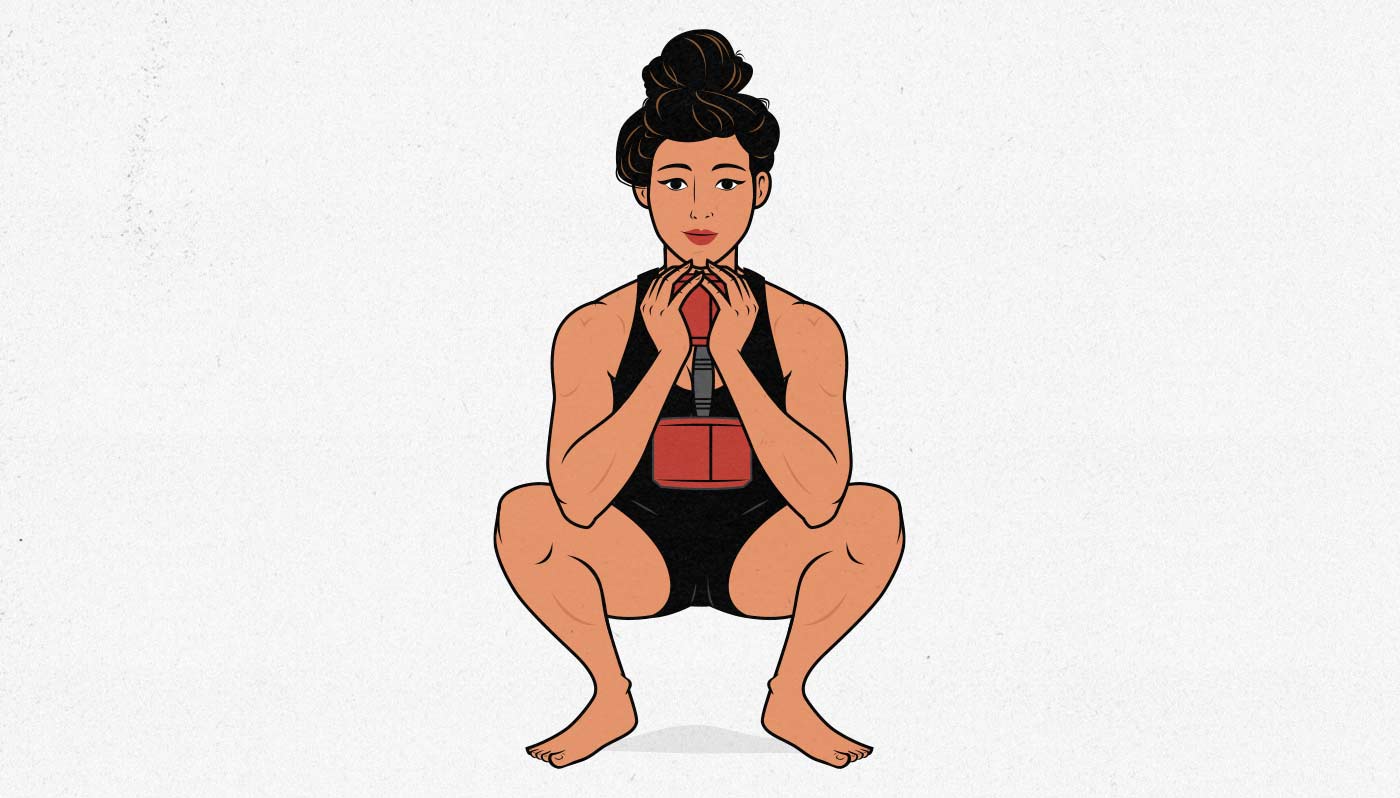
The goblet squat has us holding the weight in front of us, in our hands. It’s the best variation for beginners, and there are a few reasons for that:
- All we need is a dumbbell.
- It’s simple and intuitive to learn.
- It keeps our torso upright, allowing us to squat deeper.
- It develops strength in our upper bodies, giving it greater carryover to our real-world strength, as well as to our other lifts.
- It’s easy to mix into supersets and circuits. Just bring a dumbbell over to your workout area and you can mix in your squats alongside your other exercises.
However, it’s not only good for beginners. Until we can do fifteen or more repetitions with our heaviest dumbbell, it’s an absolutely amazing squat variation.
The only downside to goblet squats is that our legs may grow stronger than our arms, at which point our arms will get a greater growth stimulus than our legs. A beginner’s legs will grow with even a modest stimulus, so this isn’t a problem at first, but as we move into the intermediate phase, we want to make sure that we’re bringing our glutes and quads close enough to failure to stimulate reliable muscle growth. That’s where the barbell squats come in.
Goblet Squat Video Demonstration
Here’s Marco coaching Simone through the Goblet Squat:
The Barbell Front Squat
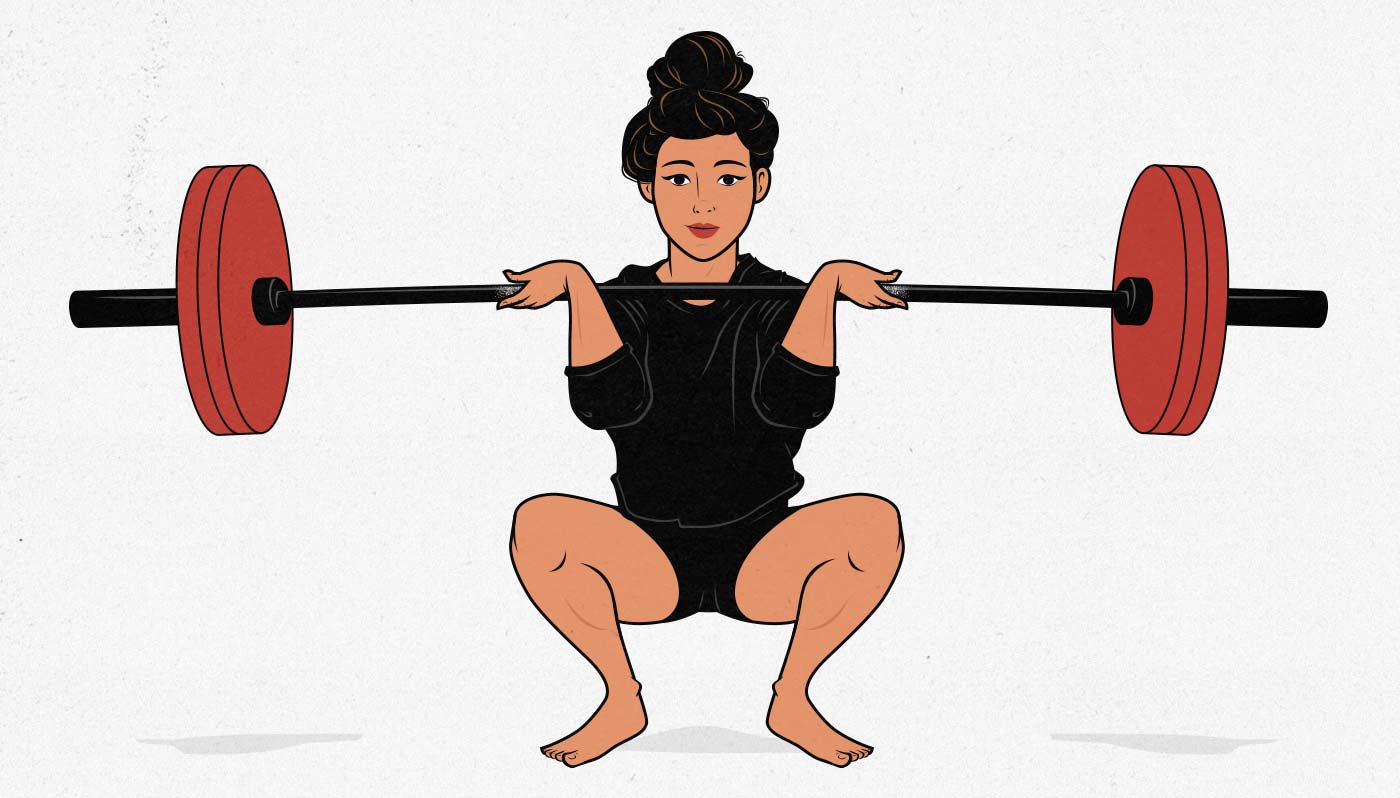
The front squat has us holding the weight up against our necks, in the crook between our shoulders and our collarbones. It’s a great all-around squat and a true full-body lift.
On the plus side, the weight is held in front of us, which allows—or rather forces—us to squat with a more upright torso. The more upright our torso is, the less likely our hips are to jam up against our thighs, and so the deeper we’ll be able to squat:
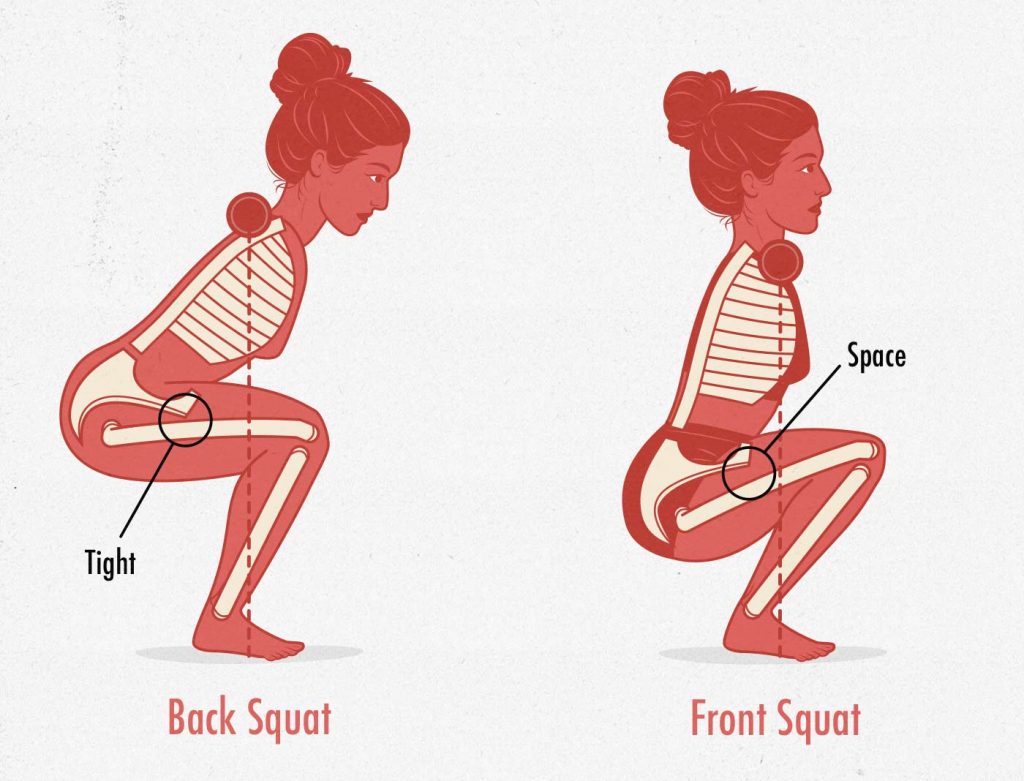
Furthermore, supporting the weight in front of us means that our upper back muscles will need to fight to keep us from caving forwards:
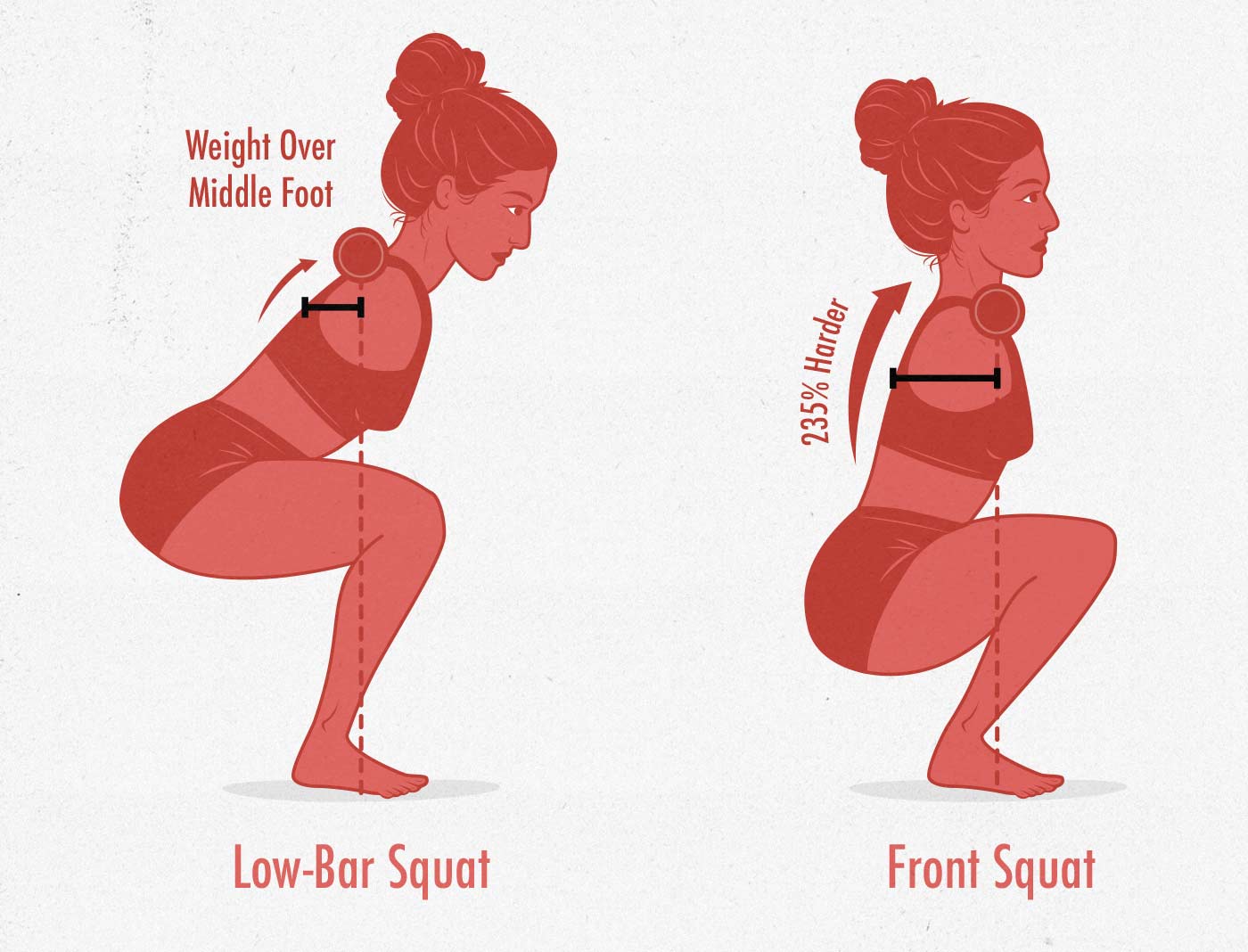
What we’re seeing here is that the moment arm is much bigger in the area of our thoracic spines, meaning that our spinal erectors will need to work much harder to maintain good posture while front squatting (as opposed to back squatting). Working those postural muscles under such a heavy load will make them much stronger over time.
As you can imagine, those are the very same muscles that help us stand taller and straighter, and so front squats are known for being one of the best lifts for improving posture:
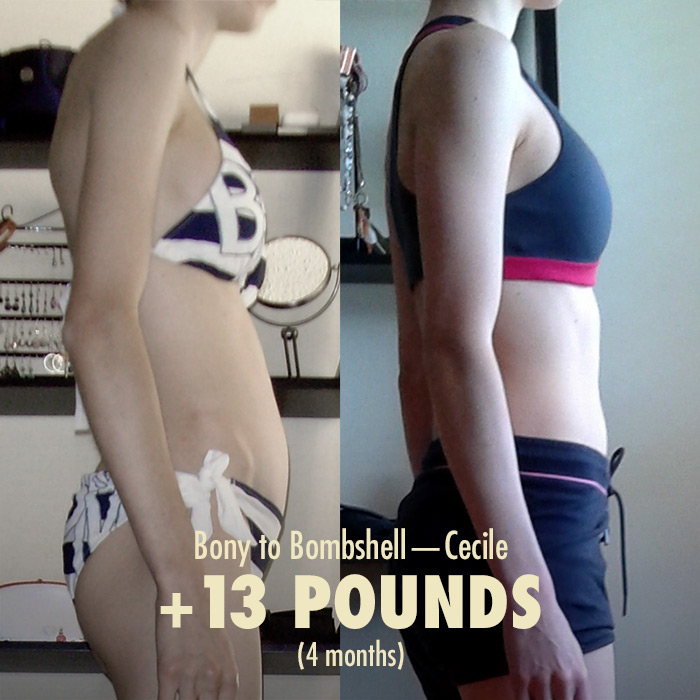
In addition to helping us improve our posture, being able to hold heavy things in front of us also has massive carryover to our real-world strength. For example, my wife prefers the front squat because it gives her the back strength that she needs to carry around our son.
On the negative side, there’s a chance that your back strength will be your limiting factor. If you’re ending your sets because your back is starting to round forward, then that may mean that you haven’t brought your glutes and quads close enough to failure yet.
It’s also a bit of a tricky lift to learn. Some women feel like they’re being strangled by a rough steel barbell. Other people find it painful on the tendons in their fingers and forearms. These problems go away after a couple of weeks—you’ll get more comfortable with the barbell against your neck, and you’ll develop more flexibility in your upper body—but in the meantime, it can be torture.
Takeaway: the front squat is an amazing squat variation, it’s our personal favourite, and it may even be the best all-around full-body bulking lift. However, depending on your goals, there’s a case to be made for the back squat as well (and most of us should master both).
Barbell Front Squat Video Demonstration
Here’s Marco coaching Marielle through the barbell front squat:
The Back Squat
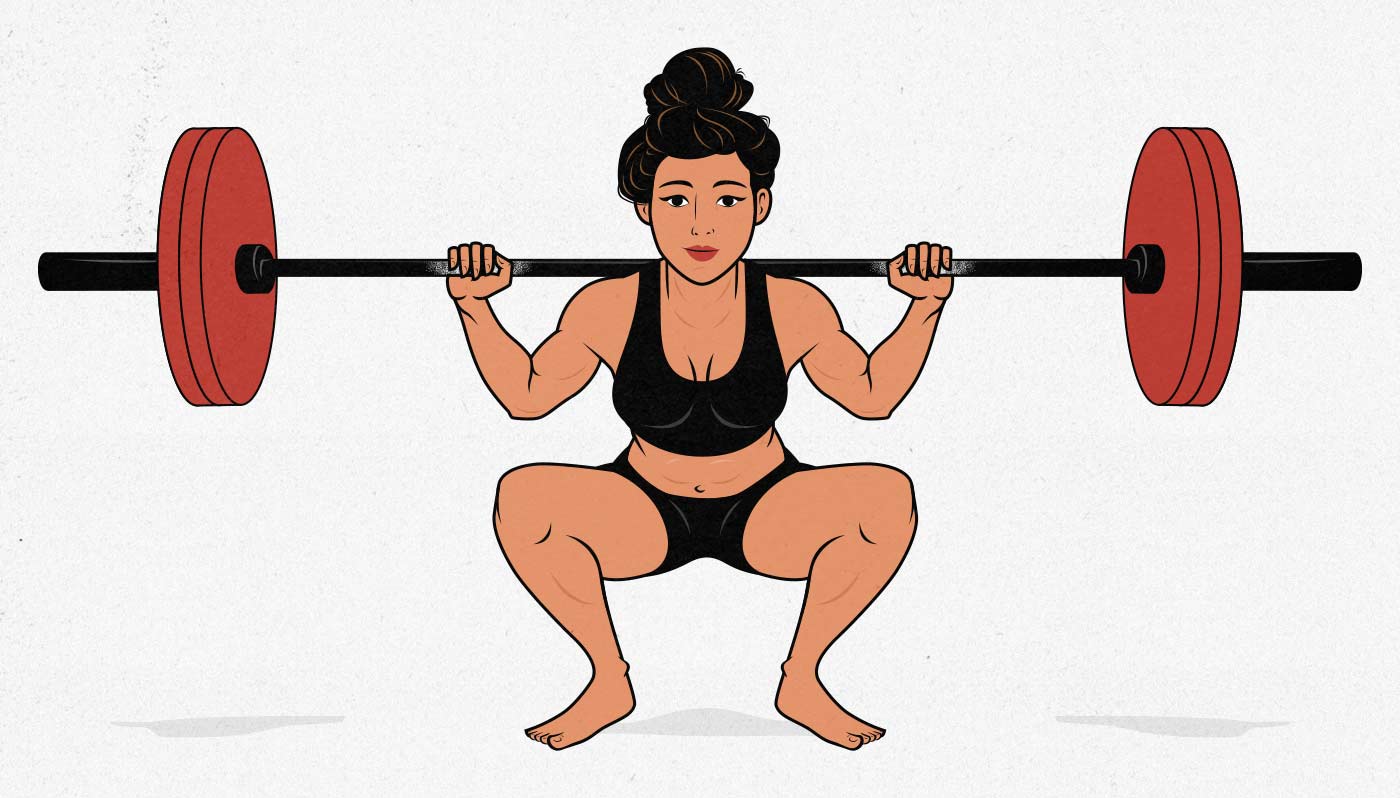
The back squat is the most popular squat variation, and it has us resting the barbell on our backs. We could subdivide back squats into low-bar and high-bar squats based on how high you place the barbell on your back. Still, both of those variations have more in common than not (and unless you’re a powerlifter, you should probably be placing the barbell higher anyway—on top of your traps).
The back squat forces us to lean forward as we squat, creating a deeper hip angle and lengthening the moment arm for our glutes. We can further emphasize this effect by “sitting back” into the squat instead of “sitting down” into the squat, further lengthening the moment arm for our hips.
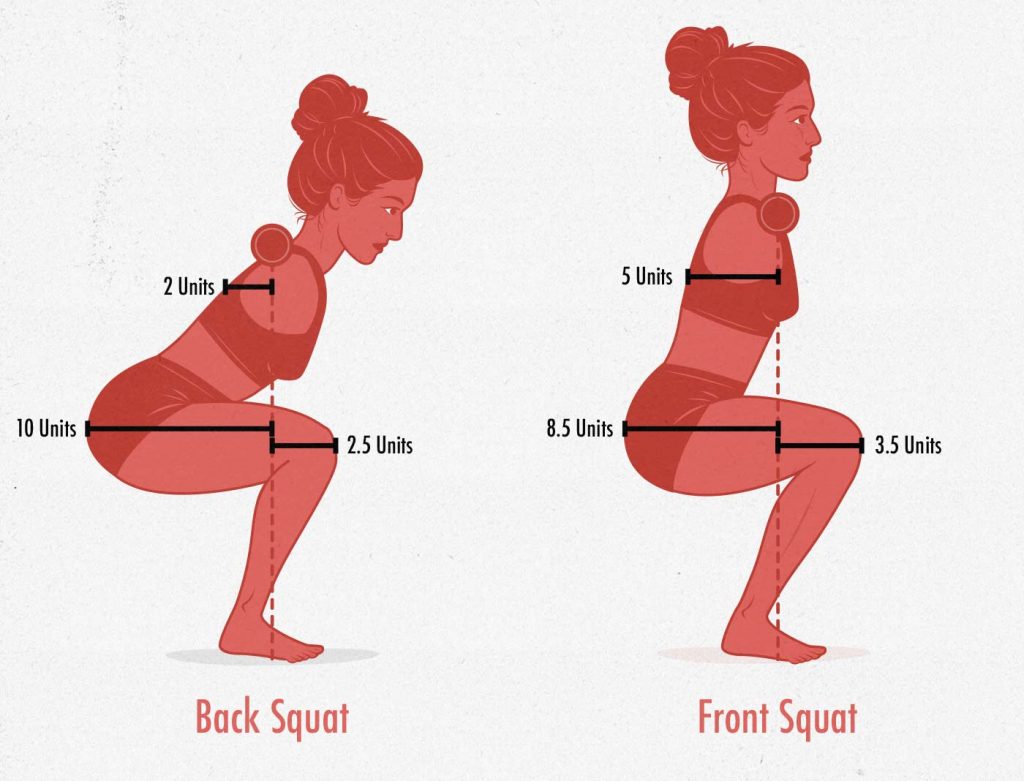
What we’re seeing here is that the back squat is slightly more challenging for our hips, a little bit less challenging for our quads, and much less challenging for our upper backs.
Because our quads tend to be our limiting factor while squatting, and because back squats are easier on our quads, most of us can back squat 25–35% more weight than we can front squat. However, even with all of that extra weight, most of us will still be limited by our quad strength. As a result, back squats are about the same for our quad development, but because we’re lifting more weight and have a longer moment arm for our hips, we might get some extra glute growth.
The next thing to consider is our hip and knee angle when squatting:
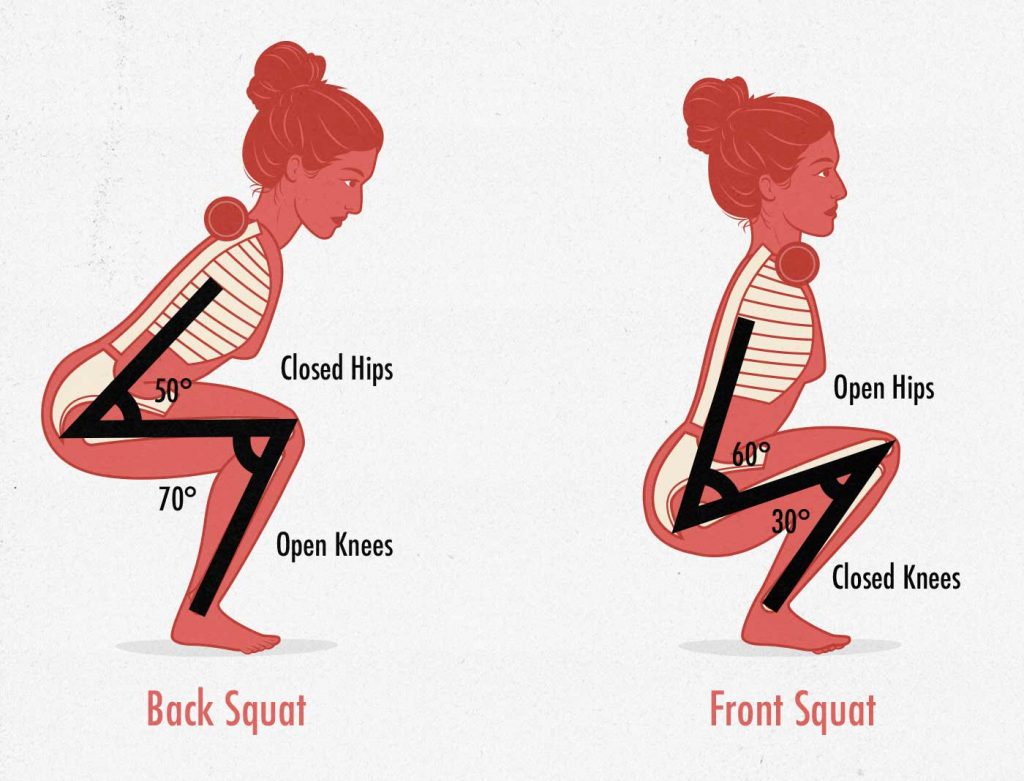
What we’re seeing here is that back squats have us bending less at the knees, and more at the hips. That means that with back squats, we’re working our hips through a larger range of motion, which is great for glute growth.
However, despite these advantages for glute growth, keep in mind that deadlifts also have a deep hip angle and a large moment arm on the hips. If a program includes both front squats and deadlifts, we’re getting the benefits of both worlds anyway. There’s no need to turn our squats into deadlifts by driving our hips back like that.
A potential downside to back squats is that they can sometimes cause hip pain, and they aren’t always easy on our shoulders. These are issues you could deal with as they present themselves, though. For example, if back squatting ever started to hurt your shoulders or hips, you could always switch to safety-bar squats, which have all the benefits of back squats but without the wear and tear. The only downside is that you’d need to get a safety bar.
The main downside to back squats is that they aren’t anywhere near as good for improving our upper back strength or posture as front squats are. They’re less of a full-body lift, more of a lower-body lift. And that’s fine.
Takeaway: back squats might be better for bulking up our glutes, they’re equally good for women bulking up their thighs, but we lose the benefit to their backs, and they can, in some instances, put more wear and tear on their lower backs, shoulders, and hips.
Barbell Back Squat Video Demonstration
How Many Squats For Women To Build Muscle?
How Many Reps Of Squats?
How many reps should you do to gain muscle mass? In strength training, doing five reps per set is a popular way to gain mass. In bodybuilding, though, where the goal is to build bigger muscles as fast as possible, most people do sets of 8–12 reps. Which rep range stimulates more muscle growth?
Sets of 1–5 stimulate less muscle growth than sets of 6+ reps, making them less efficient. And sets of 20+ reps are more painful, making it difficult to push ourselves hard enough to stimulate growth. That’s why 6–20 reps is often dubbed the “hypertrophy rep range.”
For squats, we recommend 5–12 reps per set.
How Many Sets Of Squats?
How many sets of squats should you be doing per week to build muscle? If you train efficiently, optimizing every factor for muscle growth, you may be able to maximize your rate of muscle growth away with as few as 9 sets per week.
The ideal training volume for building muscle is around 9–18 sets per muscle per week. If you’re choosing good lifts, doing 6–20 reps per set, and bringing those sets within 1–2 reps of failure, the bottom end of that range is often enough to maximize muscle growth.
Remember to increase your training volume gradually. More isn’t necessarily better.
Starting with 2–3 sets of squats per week is often plenty for beginners. You can get dramatic newbie gains with relatively low training volumes, especially at first. Then you can add more sets as you need to, to see continued growth.
Summary
Goblet squats are the best beginner variation, and they remain a great choice until we can lift the heaviest dumbbell for at least fifteen repetitions. The only downside to goblet squats is that our upper-body strength can be a limiting factor, which could hold back our lower-body growth.
Front squats work our quads through the largest range of motion. They’re the safest, they’re the best for our posture, and they stimulate the most overall muscle growth throughout our bodies. The one downside is that our glutes are worked through a smaller range of motion, but we have the deadlift for that anyway.
Back squats, especially if we “sit back” into them, are likely the best squat variation for building up our hips and butts. However, remember that we also have deadlift variations that work our glutes through that exact same range of motion.
By default, we generally use the front squat as our main squat variation and the back squat as a secondary variation, but there are no hard-and-fast rules, and we all have slightly different biomechanics. You can experiment and see which squat variations suit you best.
If you liked this article, you’d love our muscle-building newsletter for women. We’ll keep you up to date on all the latest muscle-building information for women. Or, if you want us to walk you through the process of building muscle, including teaching you the lifts, giving you a full workout program, a complete diet guide, a recipe book, and online coaching, check out our Bony to Bombshell Program.


